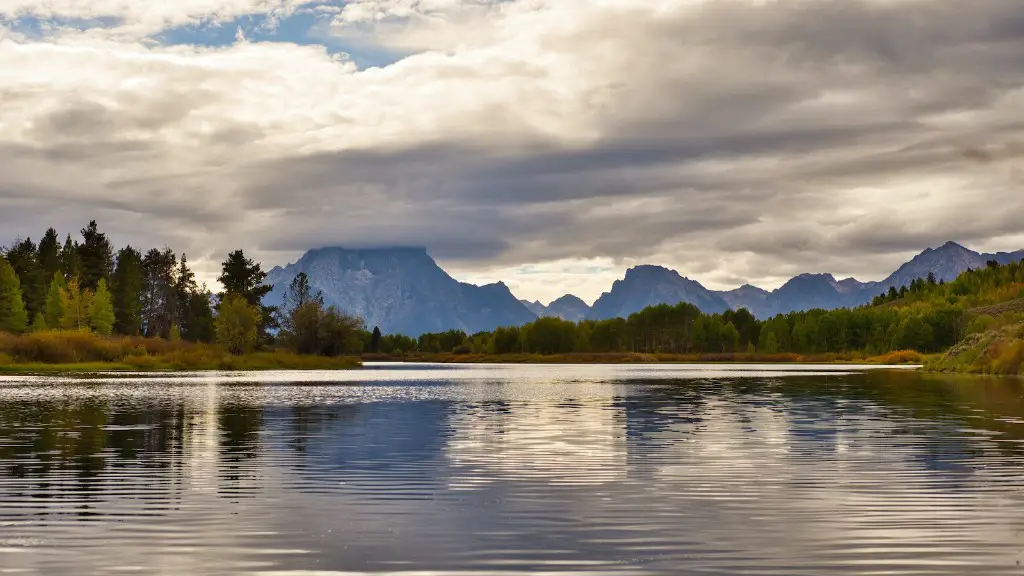The Nile river is one of the oldest rivers in the world and it is the longest river in Africa. It stretches across 11 countries in Africa, beginning in Burundi and flowing through Rwanda, Tanzania, Uganda, Ethiopia, the Democratic Republic of Congo, Kenya, South Sudan, Eritrea, Sudan, and Egypt. With its vast length, the River forms the longest shared waterway in the world.
The Nile River is not just important for the countries and people who live along its shores, it also plays an integral role in the economies of the countries it traverses. It has historically served as a main artery for transportation, as well as a major source of drinking and irrigation water. This is because the River carries sediments and nutrients from Lake Victoria, located in the tropical region around the equator. Additionally, it serves as a main source of power for families, industry, transportation, and infrastructure.
The countries that share the Nile River have been in existance for thousands of years. As a result, the Nile is deeply embedded in the culture, religion, beliefs, and mythology of all Nile riparian countries. For example, in Egypt, the Nile has been a source of life and livelihood since Ancient Egyptian times and is viewed as a source of spiritual power. In Ethiopia, the Nile is considered to be the longest river in the world, and thus, its waters are revered and revered with various religious festivals occurring along its course. This example is only one of many in which the Nile holds special historic, cultural, and spiritual importance to the countries that make up its watershed.
The Nile’s water resources are managed differently depending on the country. In Egypt, irrigation is regulated by a Directorate of Agriculture, while in Ethiopia it is regulated by the Ministry of Water, Irrigation, and Electricity. Sudan also has its own water authority, and its six major rivers that drain into the Nile have an estimated combined potential of generating 15,000 megawatts of hydro-power annually. Many other countries in the Nile basin depend on the river for their water supply, and its water is heavily utilized for agricultural purposes.
In recent years, the countries that directly share the Nile have faced a number of challenges due to population growth, climate change, and increased water demand. Shared water resources are becoming more strained, as more and more countries are now involved in the management of the Nile. In particular, the countries that are downstream, such as Egypt, have raised concerns about the upstream countries’ usage of the Nile’s waters, which they say is threatening their water security. In response, upstream countries have called on downstream countries, such as Egypt, to reduce their impact on the River, as well as work together to better manage the river’s shared resources.
To better manage the Nile, the Nile Basin Initiative (NBI) was established in 1999. This initiative consists of the 10 Nile riparian countries and seeks to promote the equitable utilization and management of the Nile’s resources, share hydropower benefits, and reduce poverty in the region. The NBI has been successful in promoting cooperation between Nile riparian countries and in helping to alleviate some of the resource-related pressures that exist in the region.
Impact of Dams and Diversions
The construction of hydroelectric dams, irrigation networks, and other structures have had a significant impact on the River. For example, in recent years, countries such as Ethiopia have constructed ambitious hydroelectric dams, such as the Grand Ethiopian Renaissance Dam, which has raised fears of water shortages and drought in downstream countries such as Egypt. Additionally, in Sudan, the construction of irrigation systems, including the Merowe Dam, have reduced the volume of water flowing downstream, as well as creating downstream sediment load problems.
In order to address these issues, countries in the Nile basin have come together in an effort to better manage their shared water resources. The Nile Basin Initiative has helped to promote joint action and facilitate dialogue between different countries in the region. Through this collaboration, countries have been able to discuss and negotiate the diversion of water from the Nile in a way that respects the rights of all riparian countries.
In addition to the Nile Basin Initiative, a number of regional and international efforts have taken place in order to ensure equitable and sustainable water management in the basin. For instance, the United Nations Security Council has made a number of resolutions related to the Nile River, encouraging cooperation between the riparian states. The African Union also has a water action plan that is aimed at promoting dialogue and collaboration between countries in the region.
Conclusion of Cooperation
The cities and countries that share the Nile River have been working together for years in order to ensure equitable and sustainable management of the River’s shared water resources. These efforts have proven to be successful, as there has been a noticeable decrease in water-related tensions between the countries of the Nile basin. Additionally, the countries have been able to collaboratively work on hydroelectric projects, irrigation systems, and other infrastructure that have benefited all countries.
Despite the progress in the Nile basin, however, there is still much to be done in order to ensure the equitable and sustainable management of the river’s resources. As the populations of Ethiopia and its surrounding countries continue to grow, it is likely that the demand for water will increase and the Nile countries will have to come back together in order to address the various water-related challenges that exist.
Economic Benefits of the Nile River
The countries that make up the Nile River basin experience many economic benefits from the waterway. The river provides a primary source of income, both through its direct use in the form of hydropower and irrigation, as well as through its indirect use as a major transportation route. Additionally, the Nile provides an avenue for countries to trade with one another, as well as an important source of food and drinking water. By increasing regional cooperation, these economic benefits can be even further realized.
In Egypt, for example, the Nile plays an important role in the country’s economy. Egypt is the largest economy and most populous country on the Nile, and thus is heavily reliant on the river for irrigation and hydropower. Egypt also relies on the river for its tourist industry, as the Nile has long been a source of attractions for tourists. This is also true for other countries on the Nile, as the river has become an important source of revenue. In Ethiopia, the Nile is a lifeline for transporting goods to the capital city and surrounding areas, as well as providing access to the Red Sea.
In summary, the countries of the Nile River share a unique relationship with the river, due to its long, winding course and its importance to the region’s economy. In order to better manage the river, countries in the basin have come together in the form of the Nile Basin Initiative, seeking to promote joint action on a wide range of issues, from irrigation to hydropower. By increasing regional cooperation along the river, the countries of the Nile have the potential to realize the economic and social benefits of the world’s longest shared waterway.
Conflicts and Negotiations
Throughout history, the river has been the subject of multiple disputes, sometimes leading to conflict. The conflict over the Nile was one of the main factors that caused Egypt (under President Gamal Abdel Nasser) to pursue the construction of the Aswan High Dam in the 1950s. This project flooded large areas of land, displacing thousands of people in the process. This move caused immense tension between Egypt, Sudan, and Ethiopia, among other countries.
The disputes between countries of the Nile basin reached a climax in the 2010s with the construction of the Grand Ethiopian Renaissance Dam (GERD). Ethiopia argued that the project would benefit the region by producing much-needed energy and providing more economic opportunities. Egypt, however, opposed the project and argued that it would reduce the flow of the Nile. In response, both countries engaged in a series of negotiations, which eventually culminated in the 2020 Agreement, which allowed for the construction of the dam, while also providing a framework for collaboration and cooperation.
These negotiations have served as proof that, with proper dialogue and collaboration, the countries of the Nile basin can reach an agreement and benefit from the shared water resources. The 2020 Agreement is an example of how the countries have been able to work together and manage their shared resources in a sustainable and equitable way.
Environmental Effects of the Nile River
As one of the oldest rivers in the world, the Nile River has already seen its fair share of environmental effects. From increased water demand to the construction of dams, the river has suffered from the effects of human activity. As a result, the Nile has experienced an 83 percent decrease in its water flow since the construction of the Aswan High Dam in the 1950s, with multiple species of fish facing extinction.
The construction of dams and other infrastructure on the Nile has had a serious impact on the environment. As the water flow is unable to reach its natural course, silt, the material deposited by rivers, is not able to reach the marine environment, leading to a decrease in biodiversity. Additionally, the dams have caused an increase in water-borne diseases, caused by the mixing of raw sewage and agricultural runoff that enters the River due to low water flow.
To address this issue, countries have come together in order to create a framework for sustainable water management in the region. This includes steps such as the disclosure of data and information on water use, improved wastewater management, and effective monitoring and regulation of water use.
Impact on Communities
The Nile River is not only important to the countries of the basin, but it is also essential to the people and communities who live along its shores. The Nile has played a significant role in the development of the economy and livelihoods of Nile riparian countries, providing employment opportunities and access to basic necessities such as food, water, and health care.
The communities living along the Nile have also been affected by the environmental impacts of dams, diversions, and other infrastructure. As the water flow is unable to reach its natural course, crops, fishing grounds, and other sources of livelihood are at risk. These communities also face risk from increased water-borne diseases and water scarcity. Furthermore, the displacement of communities due to flooding caused by dams and other infrastructure is an ongoing issue.
In order to lessen the impact of human activities on the River, countries have begun to look towards sustainable solutions. Through the various initiatives that have been created, countries in the basin are working together to increase access to safe drinking water, manage wastewater, and protect communities from displacement due to climate change.
Future of the Nile
The countries that share the Nile River face various challenges, from water scarcity to climate change. However, the Nile is far from a lost cause. Through regional cooperation and collaboration, countries have been able to work together in order to manage the shared water resources of the Nile in an equitable and sustainable manner. In recent years, initiatives such as the Nile Basin Initiative (NBI) and the 2020 GERD Agreement have been successful in promoting dialogue and encouraging collaboration between countries in the region.
However, there is still much that needs to be done in order to ensure the equitable and sustainable management of the River’s resources. Countries in the basin must continue to work together in order to ensure the communities living along the river are supported, and the environment is protected. Only then can the countries of the Nile ensure that the world’s longest shared waterway remains a source of life and livelihood for many years to come.





